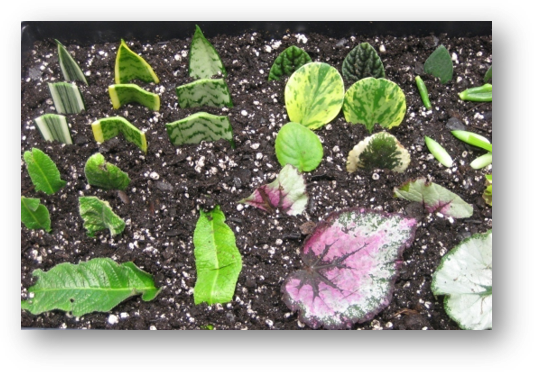The subject of plant propagation by leaf and cane is a continuation from my article on propagating plants by layering, written in late October. Plants can be generated in multiple ways with leaf and cane techniques emerging as a possible indoor winter and early spring project. Not all plants can be propagated with a leaf or parts of leaves. Fortunately, some of the plants that can are ones we all enjoy growing indoors or in protected areas outdoors, like a covered porch and other similar locations. Do an assessment of indoors windows with bright light and a few hours of sunlight for the best success. If you are fortunate to have a backyard greenhouse that is heated, you may want to try it there.
One of the simplest ways to grow a new plant is by clipping a leaf and petiole section off an existing plant that has certain characteristics you like (bloom color or the growth of the plant). African violets and sedum are plants that can be easily propagated in this manner. The length of petiole connected to the leaf should be around 1 ¼ – 1 ½ inches in length, this portion of the leaf will be planted in potting mix. I would suggest planting two in a small to medium sized container to increase the chance of a successful rooting and the new plant establishing. When the new plant leaves have emerged, usually in 6 – 10 weeks, they are clipped away from the original leaf and petiole. Some will reuse the original and replant, but I tend to discard and begin with a new one.

Next up is trying to propagate using a leaf without the petiole. This form of propagation can occur with plant that possess fleshy leaves that are thicker, with more energy to produce a new plant. The jade plant, snake plant and African violet are examples of plants that root and form new plants successfully in this way. Place a leaf or a piece of leaf vertically into a container filled with slightly damp plant media. Be sure the leaf midvein is placed into the soil as this will likely be the site of the new plant’s emergence.
Cane cuttings are yet another process for propagating a new plant. If you have ever grown a Dieffenbachia, better known as dumb cane or corn plant, they can become leggy and require staking to keep limbs from bending away from the center of the plant. If you look closely, you may see dormant adventitious buds (nodes). These buds will be the future leaf emergence area for the new plant. With a sharp clean knife cut remove a 6 – 10-inch section of the stem. The top leaf areas and smaller stem section can be removed and discarded.
Next, cut so that two stem sections are together with at least 2 nodes. Place the sections horizontally or vertically with the bottom third of the section indented into the potting media for go plant to soil contain. Make sure the node is facing upward. Once rooted with new leaves emerging, you may transplant them into a selected pot for future growth and establishment.
As mid to late spring arrives and the danger of frost passes, you can move the plants to a covered porch or under tall shade trees with filter sunlight for the summer and early fall. Enjoy creating new plants and maybe share a few with family and friends!
- Deer Damage in the Landscape - February 22, 2024
- Gardeners: A Critical Link to Protecting Our Water - January 18, 2024
- Propagating Plants by Leaf and Cane - December 14, 2023
